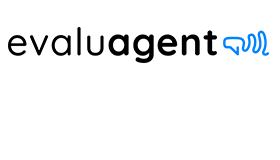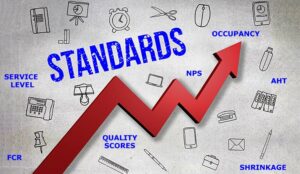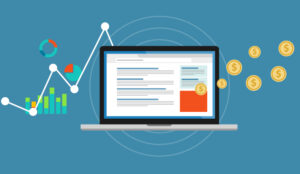Improving your business’s bottom line is great – but improving it alongside exceptional customer service is even better.
We are passionate about allowing you to offer great employee experiences which equate to great customer experiences. To enable this to happen, it’s really useful to use customer service metrics to keep track of what’s happening in your business.
Many businesses fail to harness the power of the data that they have within their reach – yet it can provide you with vital insight into what’s going well and what’s not.
Why Are Customer Service Metrics Important?
Customer service metrics are the key performance indicators (KPIs) that you can use to get the most useful information possible about the service you’re offering to your customers.
By using customer service metrics and KPIs you will be able to set standards and measure performance to ensure that your business, via your employees, is achieving as it should be.
Tracking the service and experience that you are offering your customers will allow you as a business to make improvements where they’re needed and expand and grow to your full potential.
There are multiple ways in which customer service metrics will improve your bottom line, but you’ll also notice additional benefits.
By taking the time to study the data provided, you can work to exceed customer expectations – increasing levels of satisfaction with existing customers and gaining new ones as your reputation grows.
Customer Satisfaction Score (CSAT)
This is a really useful customer service metric which measures a customer’s satisfaction with products, services or interactions that your business has provided. It is usually obtained and measured via a customer satisfaction survey.
By using a Customer Satisfaction Score you can identify where your customers are having issues with the services that you offer – directly leading you to where you can place your efforts in making improvements.
You will be able to gauge whether you have met customer expectations and understand how you can improve this to consistently exceed them.
Often CSATs are useful to get in-depth information that goes beyond a binary ‘Good’ or ‘Bad’ answer. You can indirectly gain more detailed insights into the demographic of your customer and offer them what they view as most important to them in choosing a company to use for their needs.
Time to Respond
This is a very simple customer service metric that you should be continually tracking in order to ensure you are offering customers the best service possible.
Sometimes referred to as First Response Time, this metric refers to how long it takes for your customer service agents to respond to your customers after their initial contact – whether this is via a query that has been submitted or via a direct call.
Customer service agents need to be aware of the importance of responding to customers as quickly as possible. Quick response times can result in satisfied customers and more new customers – resulting in improvements in your bottom line.
With so much competition in the marketplace and more and more companies offering instant access to information and contact, you can’t afford for your business to be slow to respond.
Resolution Rate
When a customer calls with an issue to be resolved, it’s the role of your customer service agents to find a solution and action it as quickly as possible.
Resolving issues is one of the most important roles your customer service agents have, and the resolution rate is an excellent metric to help you see how effectively they are working. If issues aren’t being resolved then customers may leave your company to go with a competitor, which could seriously affect your bottom line.
This customer service metric will measure the outcome of each call handled. You will be able to assess the overall number of issues being resolved, and find out to what extent they are being resolved – either fully, partially or not at all.
If customer service agents are not achieving a high resolution rate, you may want to offer them training with regard to:
- Phone etiquette
- Use of software
- Tone of voice and manner
- Knowledge of all business products
- Shadowing senior members of staff or those with better resolution rates
NPS score
Net Promoter Score is a key customer service metric based on your existing customer’s loyalty and satisfaction levels. It is well known as a way to measure customer service levels within a company and helps to track the approval rating of customers across all different industries.
With a higher NPS score you can expect higher numbers of repeat customers as well as referrals from those existing customers. This will obviously help to improve your bottom line as your business and customer base expands.
The way that the NPS score is gained is by using a 0-10 scale to ask customers how likely they would be to recommend your service or business to a friend, family member or colleague.
Customers who respond can be divided into the following groups according to their NPS score:
Promoters:
The customers who offer a rating of between 9 and 10 are loyal to your business and will be repeat, long term customers who will also refer others to use your services
Passives:
The customers who offer a rating of between 7 and 8 will be satisfied but may look elsewhere at other offerings that appeal more to their needs. They are unlikely to recommend others to use your business.
Detractors:
Any customer who offers a rating of less than 6 may be unhappy with the customer service or experience they have had with your business. They have the potential to damage your bottom line by leaving your business and speaking negatively about it to other potential customers.
You can calculate the NPS with a simple sum – just take away the percentage of detractors from the percentage of promoters. The range will be from -100 to 100. The higher the score, the better the outlook for your bottom line.
SLA
Service Level Agreements are another useful customer service metric that can help improve your bottom line. As a business, you have the ability to determine your own SLAs.
In your call centres, SLAs will relate to a set of clear guidelines that specify the customer service standards that your customer service agents will meet during their interactions with your customers.
Some of the factors that you may want to consider will include:
- Percentage of calls that are answered (often within a set amount of time/rings)
- Average time to respond to customers
- Average time it takes to handle calls and resolve issues
With clear SLAs in place, you will be in a much stronger position to give your employees a better experience by setting them up for success.
Meeting SLAs helps to improve your bottom line as your customer service agents will be working coherently towards, and achieving clear objectives that are widely understood.
Number of Upsells/Cross-Sells
It’s incredibly helpful to track the number of upsells and cross-sells that customer service agents are achieving within their daily work.
This easy-to-access customer service metric can help to direct you to actions that will directly improve your bottom line. You may notice that existing customers are staying with their current plans or services rather than being upsold or cross-sold to other areas of your business.
Similarly, it’s useful to track the data from new customers who should be fully briefed by your customer service agents about all potential services that they may be interested in and additional products that they may wish to purchase.
Upselling and cross-selling can improve your bottom line by increasing customer engagement as well as customer retention. Always make sure you’re monitoring all the data available in order to ensure you maximise all opportunities.
This blog post has been re-published by kind permission of EvaluAgent – View the Original Article
For more information about EvaluAgent - visit the EvaluAgent Website
Call Centre Helper is not responsible for the content of these guest blog posts. The opinions expressed in this article are those of the author, and do not necessarily reflect those of Call Centre Helper.
Author: EvaluAgent
Published On: 9th Jan 2023 - Last modified: 10th Jan 2023
Read more about - Guest Blogs, EvaluAgent






 EvaluAgent provide software and services that help contact centres engage and motivate their staff to deliver great customer experiences.
EvaluAgent provide software and services that help contact centres engage and motivate their staff to deliver great customer experiences. 








